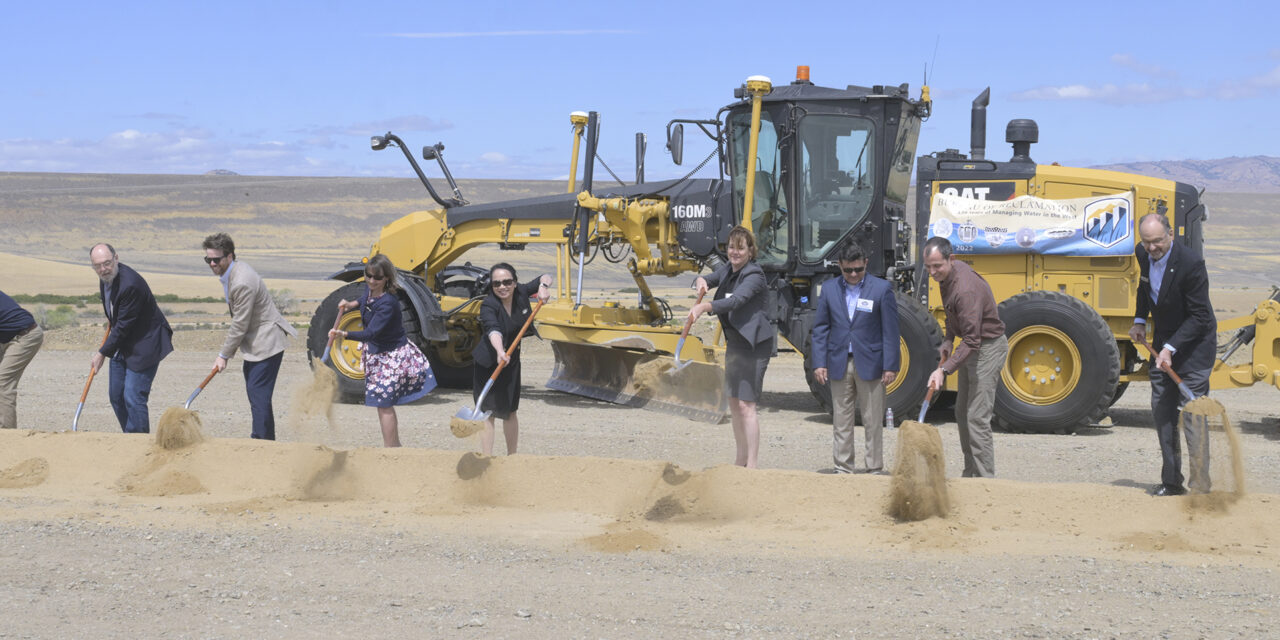LOS BANOS – The U.S. Bureau of Reclamation celebrated its 120th birthday Friday by announcing the most extensive and expensive modernization project in its history, the seismic retrofitting and enlargement of the B.F. Sisk Dam at San Luis Reservoir.
Already the largest off-stream reservoir in the United States, the crest of Sisk Dam will be elevated 10 feet to 392 feet. That will create an additional 130,000-acre feet of storage, bringing reservoir capacity to 2,170,000 acre feet. The $100 million project will also add “stability berms” for seismic integrity.
The celebration took place on Kennedy Hill, the same location where President John F. Kennedy joined California Gov. Pat Brown to break ground on the original project in 1962. Later Friday, discussions continued as many of California’s most influential water leaders gathered at Grasslands Water District in Los Banos for a summit convened by Rep. Jim Costa and chaired by Assemblymember Adam Gray and State Sen. Anna Caballero.
“If we’re going to find more water for California — for the environment, for farmers, for people to drink — we’ve got to have a lot more projects like this,” said Gray, noting that while the reservoir is in his district, it benefits Californians from San Diego to San Francisco as an integral part of the state’s water system.
Roughly 140 people attended the San Luis ceremony and celebration, including Ernest Conant, the regional director for California and the Great Basin for the U.S. Bureau of Reclamation and the Department of Interior’s Tanya Trujillo and Reclamation Commissioner Camille Calimlim Touton.
Department of Water Resources director Karla Nemeth applauded California’s leaders from 60 years ago who laid the foundation for the state’s success. “They had a vision of California’s future and they acted on that vision. Now it’s up to us to execute on projects that will provide water security for the future and for 40 million Californians.”
To create water security, Nemeth said, today’s leaders must be willing to “make bold decisions.”
Left unsaid is that bold decisions are often controversial.
When asked if any controversy has arisen around the San Luis project, State Water Resources Control Board member Dorene D’Adamo said, “The only question I hear is why we didn’t do it sooner.”
In Los Banos, Rep. Costa convened some of the state’s most influential water leaders, though he attended by phone after a positive COVID-19 test. Discussions were far less celebratory.
“California is at a crossroads,” said Federico Barajas of the San Luis Delta Mendota Water Authority, which relies on water from San Luis Reservoir. “We’re facing the impacts of climate change — having this horrible drought just two years after having the wettest year on record.”
D’Adamo talked about the necessity of water modeling using current climate conditions, not those based on increasingly unreliable historical data.
Tom Birmingham, general manager of Westlands Water District, noted that a very wet 2019 left both the federal CVP and State Water Project reservoirs virtually full. But only two years later, farmers got zero allocations after most of the water once in storage went to environmental uses.
“We fallowed 267,000 acres in Westlands alone,” said Birmingham. “The point is, that two years after one of the wettest years on record, the CVP couldn’t supply any water for (South Valley) contractors.”
Ric Ortega, who manages the Grasslands wildlife refuge water district, said it’s not just agriculture suffering. “Habitat (projects are) also fallowing record amounts of acreage,” he said. “Millions of birds are going to pass over the Sacramento Valley and land right on us” without enough food or water to support them.
“This is a conversation we’re having in every major river basin in the West,” said the Bureau’s Touton. “If we do nothing on the Colorado River we’ll hit dead-pool in 2 years. That’s how bad it is across the west. … If the farm goes, then the industry it supports goes, too. That’s not lost on me.”
The lack of data and faulty modeling tools has been especially frustrating for Gray, who has asked for an audit of the Department of Water Resources after it overestimated the 2021 Sierra runoff and released 625,000-acre feet in anticipation of runoff that never arrived. That water could have supplied every household in the Bay Area for a year with enough left for Fresno and Modesto.
“We’ve got a broken system,” said Gray. “All of the talk about conservation and efficiency, those are short-term solutions. What about the long term? How do we have water security for our state’s future? That’s what we must figure out.”




